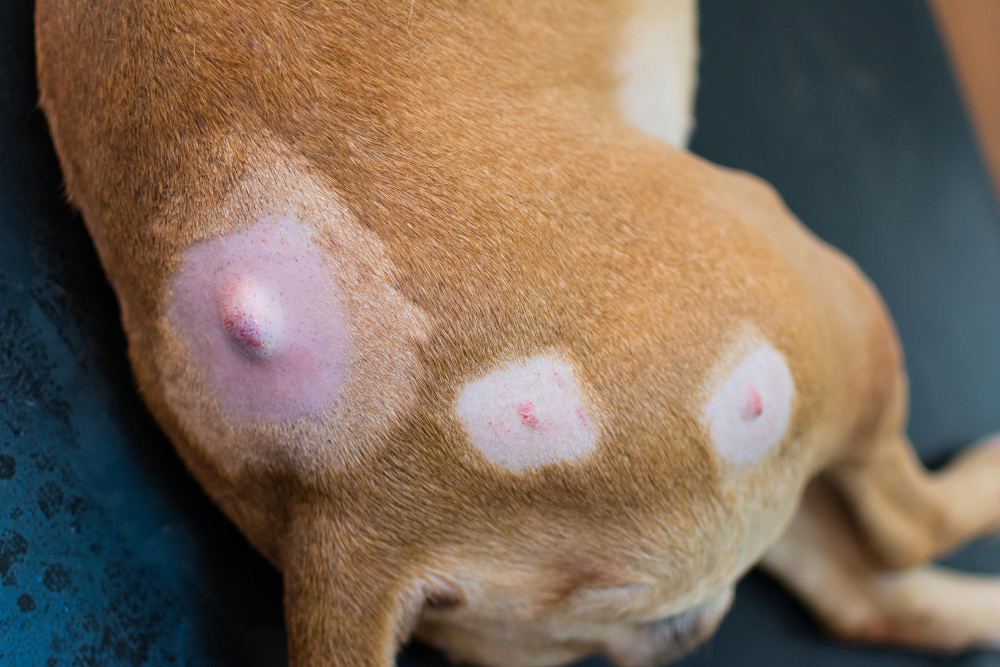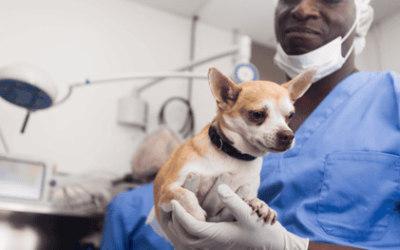Types of Cysts on Dogs [Sebaceous, Follicular & More]

Updated October 13, 2025
As a dog owner, it’s important to know the various health issues that can affect your furry friend. One common condition that dogs can develop is cysts. Cysts are fluid-filled sac-like structures that can appear on different parts of a dog’s body. This comprehensive guide will walk you through the different types of cysts affecting dogs, their causes, symptoms, and treatment options. By understanding these aspects, you’ll be better equipped to care for your dog’s health.
Understanding the Different Types of Cysts on Dogs
Cysts on dogs can vary in appearance, location, and severity. Identifying the type of cyst your dog has is crucial to providing appropriate treatment. One way to differentiate between cysts is by their color. White cysts on dogs, for example, are typically caused by blocked hair follicles or sweat glands. While these cysts are usually harmless, they can become infected and require medical attention. Sebaceous cysts, on the other hand, are filled with oily material and can be found on your dog’s skin. These cysts often appear as small, round bumps and can be easily treated by surgical removal.
Identifying Common Types of Cysts on Dogs
Several common types of cysts can affect dogs.
Sebaceous Cysts
Infected sebaceous cysts may appear red, swollen, and larger than usual. You may also notice warmth around the area or pus discharge.
Follicular Cysts
When follicular cysts become infected, they can become inflamed, increase in size, and may leak fluid. Watch for signs of redness, swelling, or irritation.
Epidermoid (White) Cysts
Infection in epidermoid cysts can lead to redness, pain, and discharge. If the cyst starts growing or becomes tender to the touch, it’s time to consult with a vet.
Dermal Cysts
Dermal cysts typically appear as raised, firm masses under the skin. However, if they become infected, they may show signs such as increased redness, swelling, or tenderness. The cyst may also start discharging pus or other fluids, causing your dog discomfort when the area is touched.
Black Cysts
Black cysts on dogs can be alarming, especially if they’re linked to more serious conditions like melanoma. If a black cyst becomes infected, you may notice redness, swelling, or an increase in size. The cyst could become warm to the touch and discharge fluid, indicating infection.
Cyst Locations:
Cysts on the Back
Cysts on the back can become infected if they grow in size, become warm, or discharge pus. An infected back cyst may cause pain or hinder mobility.
Stomach Cysts
When infected, stomach cysts may show redness, swelling, and pus, which could lead to discomfort.
Tail Cysts
Infected tail cysts may cause swelling, tenderness, and discharge, potentially affecting your dog’s movement.
Paw Cysts
Infected paw cysts often lead to swelling, redness, and discomfort, causing your dog to limp or avoid putting weight on the affected paw. You might notice pus or fluid discharge, and the area could be warm or tender to the touch.
When Should a Vet Treat or Remove Cysts?
As stated in the American Kennel Club (AKCC) article, “If your vet diagnoses the lump on your dog as a cyst, the treatment plan will depend on the type, its location, and the growth stage. If the growth isn’t too large, infected, or causing any pain or discomfort, your vet might suggest leaving it and monitoring it for any changes. Some cysts, like those caused by trauma, can naturally recede.
For ulcerated or infected cysts, non-invasive treatments, including administering medication and cleaning the area, might be the best course of action. If the cyst is causing a lot of pain or growing large, surgical removal might be necessary.
While some owners express follicular cysts themselves following diagnosis, Dr. Klein recommends that a veterinarian always looks at them first. Owners can sometimes cause inflammation and infection or try to express a mass that isn’t a cyst.”
Dog Cysts vs Tumors: What’s the Difference?
It’s important to note that not all lumps and bumps on your dog are cysts. Some may be tumors, which can be cancerous or benign. The main difference between cysts and tumors is that cysts are typically filled with fluid, while tumors are solid masses of cells. If you notice any abnormal growth in your dog, it’s best to consult with a veterinarian to determine whether it’s a cyst or a tumor. They can perform a thorough examination and may recommend further tests, such as a biopsy, to make an accurate diagnosis.
False Cysts on Dogs: Understanding the Condition
False cysts, or seromas, are fluid-filled sacs that can develop under a dog’s skin. Unlike true cysts, which are lined with epithelial cells, false cysts are not lined and are typically caused by trauma or surgery. False cysts can appear as soft, fluctuant masses and may resolve independently over time. However, if the cysts persist or cause discomfort to your dog, they may require medical intervention. Treatment options for false cysts may include draining the fluid or surgical removal.
Benefits of Pet Insurance for Dogs with Cysts
Pet insurance offers several benefits specifically tailored to dogs with cysts. Here are some key advantages:
- Financial Coverage: With pet insurance, the costs of cyst diagnosis, treatment, and follow-up care can be covered, reducing the financial burden on pet owners.
- Accessible Veterinary Care: Pet insurance provides access to a network of veterinary professionals, ensuring that dogs with cysts receive prompt and quality medical attention.
- Preventive Care: Some pet insurance companies offer wellness plans that include coverage for preventive care, such as regular check-ups and vaccinations, which can help prevent the development of cysts and other health issues.
- Emergency Situations: Cysts can occasionally become infected or cause severe discomfort, requiring emergency veterinary care. Pet insurance can help cover the costs of emergency treatments, offering peace of mind during stressful situations.
How Pet Insurance Can Help Cover the Costs of Cyst Treatment?
When a dog develops cysts, the associated medical expenses can quickly accumulate. Pet insurance can help alleviate this financial burden by covering a significant portion of the costs. Here’s how pet insurance can help with the expenses related to cyst treatment:
- Diagnostic Tests: Pet insurance may cover the costs of diagnostic tests, such as an ultrasound or biopsy, to determine the nature and severity of the cysts.
- Surgical Procedures: If the cysts need to be surgically removed, pet insurance can help cover the costs of the procedure, including anesthesia and post-operative care.
- Medications: Pet insurance often includes coverage for medications prescribed for cyst treatment, such as antibiotics or pain relievers.
- Follow-up Visits: Follow-up visits are crucial to monitor the dog’s recovery after cyst treatment. Pet insurance can help cover the costs of these necessary check-ups.
What Does Odie Pet Insurance Cover?
Pet insurance covers various veterinary expenses, providing financial protection and peace of mind for pet owners. Here are the details of the coverage options offered by Odie Pet Insurance:
Illness & Injury Plan
The Illness & Injury Plan is an all-inclusive insurance plan designed to cover a wide range of medical needs for your pet. This plan includes comprehensive coverage for various illnesses, injuries, and veterinary services. Some of the covered items include:
- Veterinary exams and consultations
- Diagnostics (e.g., X-rays, lab tests)
- Prescribed medications
- Surgeries and hospitalization
- Rehabilitation, acupuncture, or chiropractic treatments
- Medically necessary supplies
- Euthanasia and cremation
The Wellness Plan
The Wellness Plan is a monthly membership that focuses on preventive care and covers routine veterinary services.
- Provides reimbursements for routine care items, such as wellness visits (exams and vaccines), testing and parasite prevention, dental cleanings and at-home dental care, vitamins, supplements, and more.
- Through Odie’s partnership with Petivity, a leader in smart pet products and proactive care, Wellness Plan members can also receive reimbursements for Petivity devices and health kits, as well as eligible Purina food and supplements.
- Total reimbursement up to $700 per year.
FAQs
What are cysts, and are they dangerous?
Cysts are fluid-filled, semi-solid, or solid sac-like structures appearing anywhere on a dog’s body. Most are benign and harmless, but they can become infected or cause discomfort. Always have any lump evaluated by a veterinarian to rule out serious conditions.
What are the main types of cysts in dogs?
- Sebaceous cysts: Filled with oily sebum from blocked oil glands
- Follicular cysts: Form in hair follicles with fluid or dark material
- True cysts: Have secretory lining, form in sweat glands
- Dermoid cysts: Rare congenital cysts that form before birth
- False cysts: Caused by trauma, without a secretory lining
How can I identify if a cyst is infected?
Infected cysts show redness, increased swelling, warmth, pus or foul-smelling discharge, enlarged size, pain when touched, and excessive licking by your dog. Contact your vet if you notice these signs.
Which breeds are more prone to cysts, and where do they appear?
Terriers, Boxers, Basset Hounds, Schnauzers, Golden Retrievers, Rhodesian Ridgebacks, and hairless breeds are predisposed. Common locations include the head, neck, torso, legs, mouth, between toes, and along the spine.
When should cysts be removed, and what’s the best treatment?
Remove cysts if infected, rapidly growing, painful, in sensitive areas, or affecting quality of life. Surgical removal is most effective, ensuring the lining is removed to prevent recurrence. Small, harmless cysts can be monitored.
Does pet insurance cover cyst treatment?
Yes, Odie’s Illness & Injury Plan covers veterinary consultations, diagnostic tests (biopsies, aspirations), surgical removal, medications, follow-up visits, and hospitalization if needed for cyst treatment.



